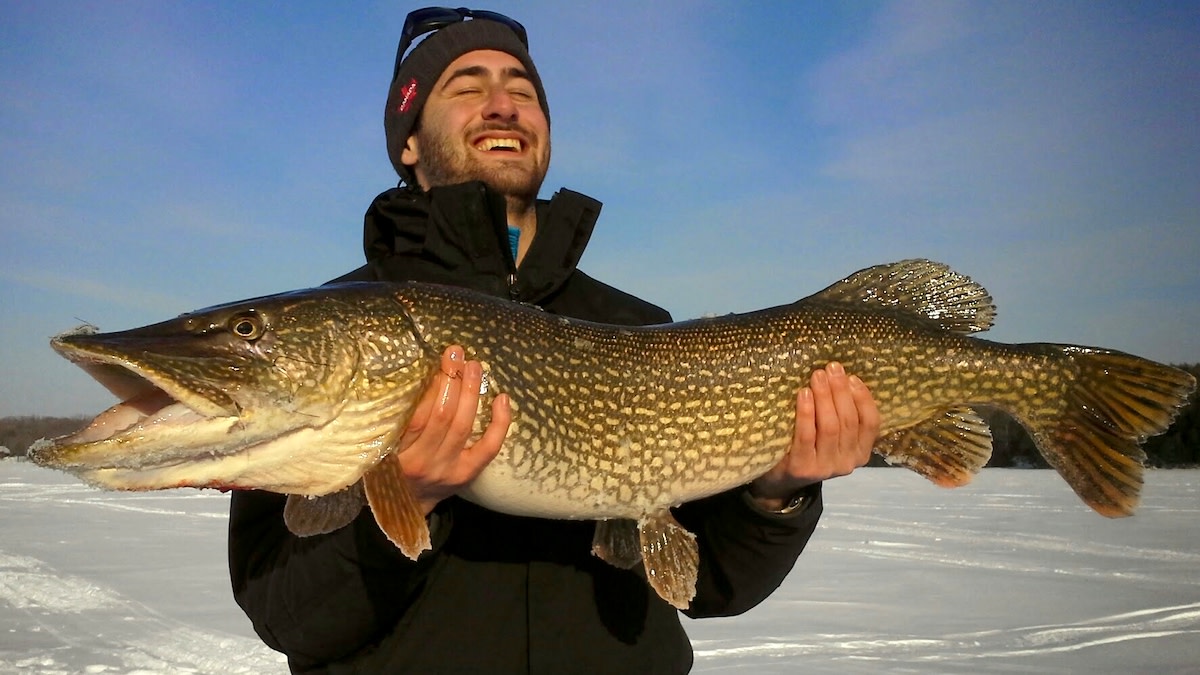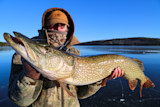
It was early March when pike patrol the shallows in pre-spawn mode. I was guiding seven anglers, several of whom had never fished before. I chose a shallow, weedy bay and spread my tip-ups to cover prime territory. I tipped my 3/0 red octopus-style hooks with lively golden shiners, 4 to 6 inches long, hooked just beneath the dorsal fin. Once secured, the shiners swam off aggressively.
The first flag popped just after sunrise. It was a 10-pounder and the angler’s first-ever hardwater fish. Over the next few hours, our crew landed 11 pike, five of which topped 10 pounds, and the largest eclipsed 20.
By late afternoon, a neighboring fisherman stopped by. He’d noticed us running to flags all day. He was fishing with dead bait and hadn’t had a bite. He showed us photos of giants he’d iced earlier in the season on dead smelt, but it was clear the pike wanted live shiners this day.
My crew had hit the sweet spot of the season with big pike searching for easy meals before the spawn. But we also presented baits the pike wanted—large, healthy shiners, placed above the weed line.
After the success of that morning, I contemplated the myriad of bait choices hardwater pike anglers face. From that experience, and from years guiding for big winter pike, I’ve compiled a list of the top three baits for hardwater giants.
Large (Not Jumbo) Golden Shiners
While it’s true that pike eat prey items over to half their body weight, they key in on more plentiful food sources that take less exertion to capture. In Maine’s Belgrade Lakes region, pike primarily feed on small landlocked alewives. Since alewives are illegal to use as bait, shiners become a prime substitute.
Four- to 6-inch shiners outproduce larger ones because their size profile better represents pike’s readily available food sources. While it’s tempting to fish jumbo baits, thinking we might tempt a new record, sticking with large (not jumbo) shiners will put more big pike on the ice.
Be vigilant with your bait dealer. Make sure your shiners are hard-swimming, have all their fins, and come from well-oxygenated, clean tanks. You’ll want them swimming hard all day—the harder they swim, the more likely a pike will home in with their sensitive lateral lines. A hard-kicking shiner also reflects light, alerting visually-oriented, toothy predators.
Medium-Large White Suckers
Maine’s state record pike (31.2 pounds, March 1998) was caught on a medium sucker around 5 inches long. Suckers are productive hardwater baits for a few reasons. First, they’re notoriously resilient. Healthy suckers swim all day, so much so that they’ll trip your tip-up if you’re not prepared.
I remember pulling a tip-up at the end of a long January day. As I approached the hole, the trap’s cross-beams vibrated from the action of the swimming sucker. The sucker survived that day and several more back in my aerated bait tank. I used the same sucker three days later, at which time it was properly dispatched by a healthy northern.
While suckers often sport a visible white underbelly and their flanks a mottled gray/brown, making them more camouflaged than shiners. Still, medium-large suckers in the 4- to 6-inch range make easy meals for hungry pre-spawn pike. Again, avoid the jumbos and stick to the medium-large profile that best represents common forage fish.
Don’t hook your sucker too deeply. Doing so risks burying the barb not in the mouth of a pike but rather in the sucker itself. Some anglers prefer hooking suckers through the mouth. I prefer to hook them just behind the dorsal, barely piercing their tough skin.
Large Sea Smelts
Smelts are fickle baitfish that require oxygenation and a bit of luck to keep alive. That said, they make fine pike bait, dead or alive. On Maine’s Androscoggin River, tidal pike snack on anadromous baitfish including large sea smelts that run the river in winter. Some anglers fish live smelts (in the same fashion as shiners or suckers) with success, while others prefer dead smelts suspended in the feeding zone or laying on the bottom.
Pike find easy prey with their keen sense of smell. Pre-spawn female pike—the true trophies we dream of—are known to scavenge dead or wounded baits. Dead smelts put off a particularly stinky scent trail that lazy pre-spawners often can’t resist.
Use a thinner-gauged hook when fishing smelts. They’re more delicate than shiners and suckers and tend to fight against any weight (split shot or heavy hook) dragging them down. To avoid smelt-twirled leader loops, fish a weightless leader and thinner-gauge hook.
Try these pike baits on your local haunts and you’ll have a good shot at landing a hardwater giant.




